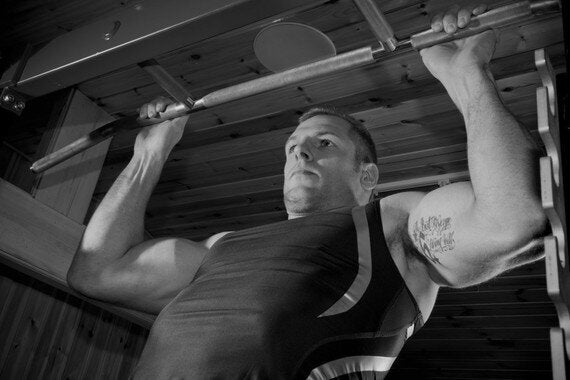It's getting to that time of year where guys at the gym start turning up in chunky hoodies and baggy sweatpants. Logic says it must be the weather; but in a climate controlled gym, this is very rarely the truth.
These guys aren't covering themselves up in extra layers to keep warm - they're doing so to try and hide the infamous 'winter bulk' they're coveting.
Conventional bodybuilding wisdom often talks about phases of 'bulking' and 'cutting' - that is, putting on as much size as you can during your bulking phase, then trying desperately to shed the fat during your 'cut.' In other words, you allow yourself to get fat, soft, and out of shape during the winter months, before panicking and drastically cutting calories ahead of your impending summer holiday in the hope that your abs will miraculously re-emerge in 6 weeks.
And, hey presto: you're back to exactly where you were when the cycle started.
Ask yourself for a second - is it really worth it?
Why bulking and cutting doesn't work
Providing you are not a complete beginner, there is only a certain rate at which you can build muscle. No matter how many protein shakes you drink or how many calories you take on board, it is impossible to force feed muscle growth. During a classic 'bulking' phase, the vast majority of the excess calories you take in will be stored as fat.
During your bulk, it may feel like you are stronger in the gym. You may well be able to add a couple more plates to the bar. But ask yourself - have you actually got stronger, or are you just able to put more weight behind it? For a true test of strength, compare how many pull ups you can do compared to before your bulk started, or how much you can squat in relation to your bodyweight.
Sure, if you are training correctly, it is likely that you will put on some muscle during your bulking phase. But when it's hiding underneath rolls of blubber, what's the point?

And then, when it's time to shred away the body fat, we are faced with the exact opposite scenario.
Just like there is a set rate at which we can build muscle, there is a limit to how fast we can burn fat. Anything else we lose will be water weight, or worse, muscle mass.
So, when calories are restricted too low during a cutting phase, we start to lose all those muscle gains we worked so hard for.
As a result, when your bulking and cutting cycle is complete, you find yourself back in the very same shape you were when it started. All that's changed is you've spent way too much money on food, a gym membership, and elasticated waistbands.
A Simpler approach - The JHHF Way
We've established that there is a set rate at which we can burn fat and build muscle. So why don't we try to work in line with our body's physiology, instead of trying to override it?
Instead of endless cycles of bulking and cutting, your primary focus should be on building lean muscle. In other words, getting stronger whilst keeping body fat levels as low as possible.
It takes a bit more discipline, but it is perfectly possible to build muscle without putting on fat. And by doing so, we are able to maintain that chiselled, athletic physique all year round.
Doesn't that sound like a much better alternative?
In order to build lean muscle, our body must be in a calorie surplus. This means that we are taking in enough calories to promote muscle growth - but crucially, not enough to trigger fat storage.
For most people, this means keeping your calorie intake approximately 10 - 15% above your basal metabolic rate. These figures will vary from person to person, and depending on your metabolism you may need to go slightly up or down. The best approach is to track your calorie intake for a couple of weeks and go up or down accordingly. If you start to notice fat gain, lower your calories. If you're not getting any stronger, bump them up. The key is to find your 'sweet spot' where you are able to build muscle without putting on fat.
Note that if you are consuming additional calories, they must be combined with strength training in order to trigger muscle growth. Otherwise, they are just going to be stored as fat.
The key to muscle building is patience and consistency. You can't build muscle overnight; but over time, the results will become clear for all to see. The best part? You won't have to spend 6 months of each year soft, bloated, and with the physique of a humpback whale.
James Haskell Health & Fitness [JHHF] helps you achieve a healthier and fitter lifestyle
We do this delivering professional fitness and nutrition advice in a simple, clear and easy to understand format. In conjunction with the development of our own range of clean and certified sports supplements, this allows the individual to achieve the lifestyle balance, which is right for them.
Remember it's not about being the best. It's about being better than you were yesterday
If you want to learn more about Health, Nutrition and Fitness, then please visit our website www.jameshaskell.com.
Please send us your questions and any comments you would like to make, via our social media channels. Plus if you feel informed by what you have read, please share the information using #JHHF #RugbyFit #jhtraining
Twitter @jameshaskellhf
Instagram @jameshaskellhf
Don't forget our all natural, multiple award-winning Pre-Training supplement, specifically designed to aid and boost your training. All our supplements are Informed Sport batch tested, so there are no additives or harmful chemicals. Informed Sport Tested and certified products are the only supplements, which members of the armed services and elite athletes can safely take. Try it here.
